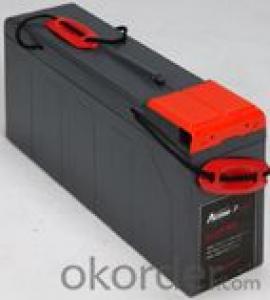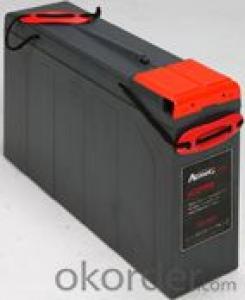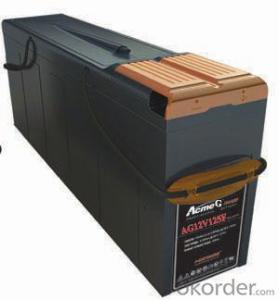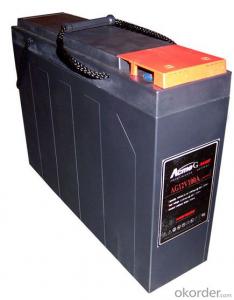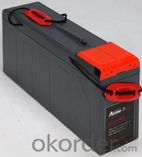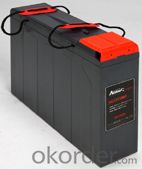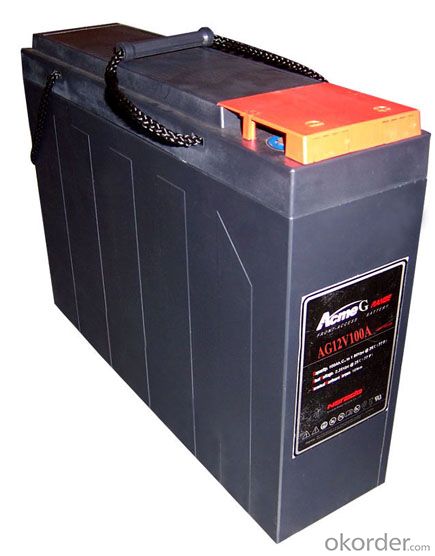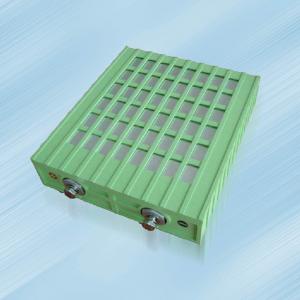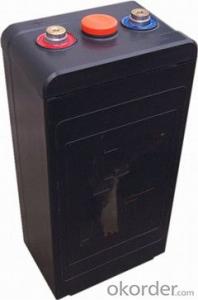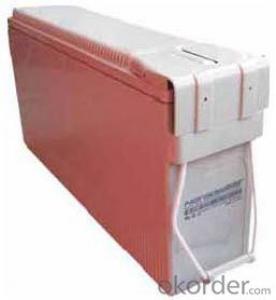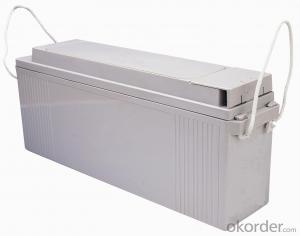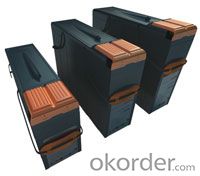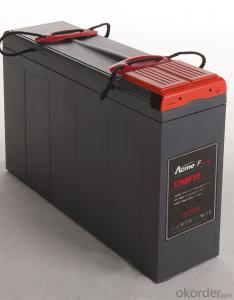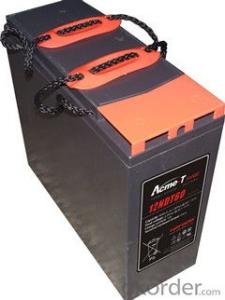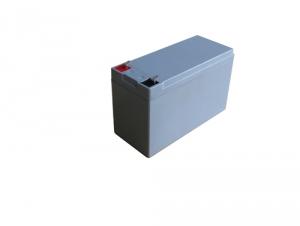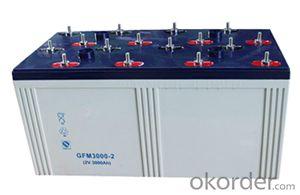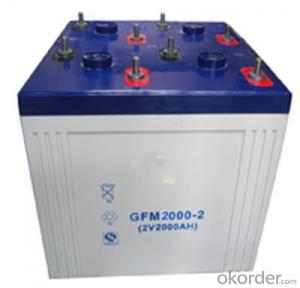Gel Battery the AcmeG Series Battery YUT
- Loading Port:
- Shanghai
- Payment Terms:
- TT OR LC
- Min Order Qty:
- 1000 unit
- Supply Capability:
- 10000 unit/month
OKorder Service Pledge
OKorder Financial Service
You Might Also Like
The AcmeG range front access gel batteries is designed based on the Acme series, using the polymer gel electrolyte with real front access structure. The state-of the-art internal and external design ensures AcmeG the high reliability and makes the installation quite simple and safe when placed on a standard relay rack tray or in a closed cabinet. AcmeG range gel battery is designed with high energy density and suitable for 19". 23" rack or cabinet.
Technical features
Long life
Using the polymer gel electrolyte
4BS paste technology
Special paste formula
Special patented grid alloyWide operational temperature range
Excellent charging and discharging ability at low temperature
Decline the water-loss at high temperaturespecial structure
real front access structure makes the installation and maintenance squite simple and safe
suitable for 19". 23" rack or cabinet
The specially centralized venting system ensures the small gas be vented our of the closed cabinet
Compliant standards
Designed to be compliant with:
IEC 60896-2
BS 6290 Part 4
Telcordia SR-4228
EUROBAT GUIDE
UL
Manufactured under system ISO9001 & ISO14001 by NARADA
Battery installation compliant with:
EN 50272-2 or local equivalents
Main applications
Telecom standby and cyclical applications
UPS
Power plant and power transfer system
Solar energy system
Emergency lighting system
Products characteristics:
float voltage: 2.25Vpc at 77oF(25oC) , Equalization charge voltage: 2.40Vpc at 77oF(25oC)
Self discharge rate: < 2% pre month at 68oF(20oC)
Design life: more than 12 years at 68oF(20oC)
Shelf life: 6 months at 68oF(20oC)
Recombination efficiency: >99%
the Pressure at which the valve opens & reclose is Opened at 10 to 35kpa(1.45psi to 5.08psi) and
closed at 3 to 15 kpa (0.44psi to 2.18psi)
Temperature ranges: -40oC to 50oC
Terminal Hardware Torque:10±0.1N m
Container Material: ABS (V0 optional)
FAQ
![]() What is a Gel Cell Battery?
What is a Gel Cell Battery?
A gel battery design is typically a modification of the standard lead acid automotive or marine battery. A gelling agent is added to the electrolyte to reduce movement inside the battery case. Many gel batteries also use one way valves in place of open vents, this helps the normal internal gasses to recombine back into water in the battery, reducing gassing. "Gel Cell" batteries are non-spillable even if they are broken. Gel cells must be charged at a lower voltage (C/20) than flooded or AGM to prevent excess gas from damaging the cells. Fast charging them on a conventional automotive charger may be permanently damage a Gel Battery.
![]() What is sulfation of batteries?
What is sulfation of batteries?
Sulfation is the formation or deposit of lead sulfate on the surface and in the pores of the active material of the batteries' lead plates. If the sulfation becomes excessive and forms large crystals on the plates, the battery will not operate efficiently and may not work at all. Common causes of battery sulfation are standing a long time in a discharged condition, operating at excessive temperatures, and prolonged under or over charging.
![]() How long a battery can last?
How long a battery can last?
The service design life of a battery are vary considerably with how it is used, how it is maintained and charged, temperature, and other factors.
![]() Do batteries self-discharge when not in use?
Do batteries self-discharge when not in use?
All batteries, regardless of their chemistry, self-discharge. The rate of self-discharge depends both on the type of battery and the storage temperature the batteries are exposed to. However, for a good estimate, Narada batteries self-discharge approximately 4% per week at 80ĄăF.
- Q: What is the difference between a maintenance-free battery and a conventional battery?
- Different materials will produce a different phenomenon: the traditional battery in the course of the use of the phenomenon of liquid reduction occurs, because the antimony on the grid will pollute the sponge on the negative plate of pure lead, weakened after the full charge of the battery Electromotive force, resulting in excessive decomposition of water, a large number of oxygen and hydrogen, respectively, from the positive and negative plates to escape, so that the electrolyte reduced. With calcium instead of antimony, you can change the fully charged battery back electromotive force, reduce the overcharge current, liquid gasification rate decreases, thereby reducing the loss of electrolyte.
- Q: How to determine the battery is good or bad?
- Observe the battery electrolyte is turbid, turbidity that the battery positive plate softening. Observe the bottom of the battery whether there is sediment, if the plate off the battery capacity has been inadequate. Hand hit the battery two electrode piles If you hear an empty voice that pole pile and plate break. With a thick wire short-circuit positive and negative pile observation of the battery filling holes, such as the discovery of a bubble appears that the interval has been damaged.
- Q: What are the hazards of battery over discharge?
- The battery discharge to the standard termination voltage when the internal resistance will become larger, the battery electrolyte concentration will become very thin, especially the battery plate micropores and battery plate surface these two points are almost neutral; battery over discharge because of Internal resistance will become larger, so the battery will appear inside the phenomenon of heat, the battery volume will appear fever expansion.
- Q: Maintenance-free battery how to detect it?
- Check the height of the electrolyte at least once a month. There is no mark line of the battery, the electrolyte added to the plate 10-15mm can be higher; there are two red line of the battery, the electrolyte can not exceed the red line above.
- Q: What are the advantages of maintenance-free batteries?
- Maintenance-free battery using lead-calcium alloy grille, the amount of water generated when charging less water evaporation is low, with the shell with a sealed structure, the release of sulfuric acid gas is also very little, so with the above advantages.
- Q: What is the meaning of the battery above 12v65Ah?
- Voltage 12V, current 65AH, that is the capacity of 65A. (A is the unit of current. H is the time unit)
- Q: 80ah how much battery storage capacity?
- 0AH storage is 80AH ah If the actual storage capacity will have to see the brand. I have seen 100AH only 24 pound. This is not even 60AH.
- Q: The role of the battery?
- Battery is a kind of battery, its role is to be able to save the limited power, in the right place to make 6v4ah emergency light battery. Its working principle is to convert chemical energy into electricity.
- Q: Battery 200ah / 104 what does that mean?
- Lead-acid battery nominal voltage is 2V / (each or monomer), but in fact will be higher than 2V, so the actual use and charging equipment for the matching will use 104, also useful 103, also useful 108 Only.
- Q: How does battery activation work?
- If the battery is charged, because the battery discharge itself, the active substance to activate, not add acid, but should be added pure water (no minerals and impurities in the water) is best steaming water, and now you Since the addition, you can use water to wash several times, and then use 1C current charge to 2.3 times. Then discharge, so repeated several times, will be better. So that you can remove the vulcanization.
Send your message to us
Gel Battery the AcmeG Series Battery YUT
- Loading Port:
- Shanghai
- Payment Terms:
- TT OR LC
- Min Order Qty:
- 1000 unit
- Supply Capability:
- 10000 unit/month
OKorder Service Pledge
OKorder Financial Service
Similar products
Hot products
Hot Searches
Related keywords
